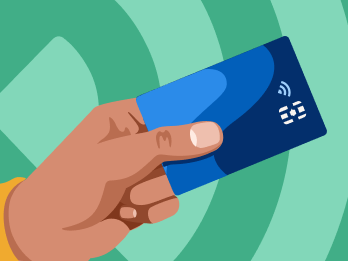What Is a High-Risk Merchant Account?

Many or all of the products featured here are from our partners who compensate us. This influences which products we write about and where and how the product appears on a page. However, this does not influence our evaluations. Our opinions are our own. Here is a list of our partners and here's how we make money.
A high-risk merchant account is required if a business with a greater risk of fraud or chargebacks — or with certain other characteristics — wants to accept credit card payments. When a customer pays by card, the funds are first held in a merchant account before being transferred to the business’s bank account. Payment processors often offer built-in merchant accounts; however, many payment processing companies won’t work with businesses they consider “high-risk.”
Businesses may be deemed high-risk based on their industry, such as tobacco or firearm sales, or because they sell internationally, have subscription pricing or don’t have much cash in the bank. That’s where high-risk merchant accounts come in.
Best Payment Processors for High-Risk Merchants
What makes a business high risk?
There isn’t a single framework or central authority in the payments industry that determines which factors are risky. Instead, each payment processor and bank compiles its own standards.
Some companies state upfront that they don’t work with certain industries, while others welcome all applicants. Generally, payment service providers are more stringent than merchant account providers about which types of businesses they accept. In either case, you’ll be asked to submit an application with specifics about your business.
Ultimately, the company will make a decision about each application based on internal criteria. Some of the risk factors a company might consider include:
NerdWallet rating 5.0 /5 | NerdWallet rating 5.0 /5 | NerdWallet rating 5.0 /5 |
Payment processing fees 0.40% + 8¢ plus interchange, in-person; 0.50% + 25¢ plus interchange, online. | Payment processing fees 2.6% + 10¢ in-person; 2.9% + 30¢ online. | Payment processing fees 2.7% + 5¢ in-person; 2.9% + 30¢ online. |
Monthly fee $0 | Monthly fee $0 Starts at $0/month for unlimited devices and locations. | Monthly fee $0 |
How high-risk merchant accounts differ from regular accounts
Higher payment processing fees. A competitive payment processing fee for a standard retail small-business account might be 2.6% plus 10 cents, while the fee for a high-risk account might be 2.95% plus 25 cents. At those rates, for a $50 charge, a standard retail business would pay $1.40, while a high-risk merchant would pay $1.73. Actual fees vary by company. Our credit card processing fees calculator can help you estimate payments.
Lengthier application process. If you need a standard small-business account, you might get approved in minutes or less. But high-risk accounts can take multiple days to get approval. High-risk merchants will be asked to share more information on their business, like bank statements, and they may have their personal credit checked.
Higher chargeback fees. When a customer disputes a charge, businesses are often subject to chargeback fees, which can range from $20 to $100 each.
Cash reserve requirements. The payment processor might hold on to some of a high-risk business’s cash as a hedge. These cash reserve requirements are usually baked into the payment process itself using the following methods:
Capped reserve. The payment processor withholds a percentage of each completed transaction until the total balance reaches a predetermined level. At that point, the contributions stop, and the reserve remains until needed. For example, 10% of your sales might be reserved until they add up to half of your monthly processing limit.
Rolling reserve. The payment processor sets aside a percentage (as high as 10%) of every completed transaction, which you receive later. If, for example, your agreement uses a six-month rolling basis, then in July you receive the balance from January, in August you receive the balance from February, and so on.
Upfront reserve. The merchant sends the payment processor a set amount that becomes the reserve. In some situations, the payment processor will instead withhold all completed transactions until the set amount is reached.
Volume caps. Your payment processor may limit the number of transactions you accept each month or the total dollar amount you process each month.
Additional technical requirements. For example, if you sell age-restricted products or services, the payment processor might require you to use tools that ensure you aren’t selling to underage customers.
Tips for finding a high-risk merchant account
If you need a high-risk merchant account, you can increase your odds of finding a payment partner by following these best practices:
Set up a consultation with a few payment processors. Because of the wide variety of business needs and risk factors, companies that offer high-risk accounts typically rely on custom pricing. A call with a company representative can give you a better picture of what each company offers, as well as its fees.
Be open and honest during the application process. Trying to disclose as little information as possible can hurt your cause. "Communication and transparency are only going to help in these situations," says Andy Roth, who was formerly the director of strategic partnerships at Payline Data, a payment processing company that provides high-risk accounts.
Ask the right questions. Don Apgar, former director of the merchant services advisory service at Mercator Advisory Group (now Javelin Strategy & Research), says to investigate not only what the partnership would look like on day one, but also what it could look like in the future with questions like:
What experience does the payment processor have in your field, and what type of support will you receive to maximize your chances of success?
How long does it take for you to access your funds, and will there be a reserve requirement?
Are there circumstances under which the terms of your agreement can change? For example, if chargebacks exceed a certain level, you might see higher costs. The inverse is true as well: Some payment processors might reduce your costs if you meet certain thresholds.
Review your cash levels. Cash on hand can signify stability. Banks like to see 25% to 50% of monthly card transaction volume sitting in your account, according to Roth.
Compile the right documents. Be prepared to share at least three to six months of bank statements during the application process. These statements should show where cash is coming from and where it’s going. Some banks might want to see a few years of tax returns, too.
Assess which variables are in your control. You can’t change whether payment companies consider your industry to be high risk, but you can take steps to improve your credit score or reduce chargebacks if those factor into your situation. Talk to your payment company to see if you can take steps to reduce your risk; there might be better rates for you if you do.
Communicate to customers clearly. Not all chargebacks are nefarious. Some are the result of unhappy customers. You can take steps to reduce those kinds of chargebacks. Is your return policy or shipping policy understandable and posted in an easily identifiable place? Can customers easily reach you if they want to resolve an issue directly?
Consider multiple payment processors. "If the payment processor shuts down a storefront, you can still accept cash," says Apgar. "But if you’re in e-commerce and you get that phone call, you’re done." He recommends thinking proactively and setting up accounts with multiple payment processors. An e-commerce business can use technology called a payments orchestration layer to facilitate payments among multiple payment processors.
On a similar note...

| Product | Payment processing fees | Monthly fee | Learn more |
|---|---|---|---|
 Helcim NerdWallet Rating Learn more on Helcim's website | 0.40% + 8¢ plus interchange, in-person; 0.50% + 25¢ plus interchange, online. | $0 | Learn more on Helcim's website |
 Square NerdWallet Rating Learn more on Square's website | 2.6% + 10¢ in-person; 2.9% + 30¢ online. | $0 Starts at $0/month for unlimited devices and locations. | Learn more on Square's website |
 Stripe Payments NerdWallet Rating Learn more on Stripe's website | 2.7% + 5¢ in-person; 2.9% + 30¢ online. | $0 | Learn more on Stripe's website |
 Shopify POS NerdWallet Rating Learn more on Shopify's website | 2.70% in-person; 2.9% + 30¢ online (Basic plan). | $39 and up for e-commerce plans with POS Lite; Can upgrade to POS Pro for an extra $89. | Learn more on Shopify's website |

